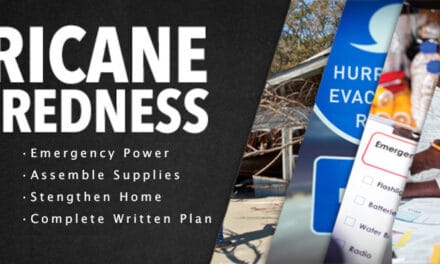FOOD SAFETY DURING A POWER OUTAGE—HOW LONG IS THE FOOD IN YOUR FRIDGE AND FREEZER SAFE?
The time a refrigerator will stay cold when power is lost depends on the brand and model and the condition of the door seals. Time can vary from 2-6 hours without opening the doors. After the power goes out, think of your refrigerator as a large picnic cooler. Blocks of ice help keep the inside cool. How long the ice lasts depends on a number of factors.
Food in the freezer will keep much longer, especially if the freezer is more than half full. You need to be aware of how long the power has been out.
The food in your fridge or freezer may look safe or smell safe even after is has become dangerous to eat or handle.
SAFE FOOD TEMPERATURES
According to the FDA (Food and Drug Administration,) maintaining perishable food at temperatures below 40º Fahrenheit is an important food safety rule. When food temperatures exceed 40º, bacteria present in the food begins to grow more quickly. Unsafe food may not look, smell, or taste bad, but the bacteria growing in it could make your family sick. Food-born illness isn’t always just an upset stomach and it may have serious consequences. Unsafe food makes up to 48 million Americans sick every year, including the hospitalization of 120,000 people and the deaths of 3,000 more.
Hang inexpensive and easy to read refrigerator / freezer thermometers in your refrigerator and freezer where it’s always in view.
- Salmonella is responsible for millions of food poisoning cases every year and is the leading cause of foodborne deaths.
- E. coli bacteria can cause serious and sometimes deadly infections. Cases range from 20,000 to 40,000 annually.
- Clostridium botulinum produces a deadly toxin that causes botulism. Symptoms include muscle paralysis including loss of the ability to breath. 5-10% of cases result in death.
- Other foodborne illnesses create severe health problems.
While the FDA recommends storing perishable food at temperatures below 40 degrees, how long does it take before food becomes unsafe?
The safe time limit for perishable foods after the surrounding ambient temperature rises above 40 degrees (and less than 90 degrees) is two hours. This applies to perishable groceries, leftovers, restaurant carry-out or doggie bags, and food in a refrigerator. If you have an average refrigerator, you can probably count on it to maintain a safe temperature for about four hours—if you don’t open the fridge door. For an additional two hours, your food remains safe if you’re able to cool it back down below 40 degrees.
Food that was frozen remains safe at temperatures above 40 degrees as long as there are ice crystals. Once those are gone, the two-hour clock starts ticking.
Cut your “Safe Time” in half if the ambient temperature is 90-degrees Fahrenheit or higher.
40 degrees is the maximum (highest) temperature at which you should store perishables, but what does that mean once the power goes out if the temperature is already at 40 degrees? Ideally, you should set your refrigerator to a setting that holds the temperature closer to 35 degrees on the top shelf. That bottom shelf in the back is probably two or three degrees colder—ideal for meats, poultry, and seafood.
FOOD SAFETY RULES FOR POWER OUTAGES
Safe or Unsafe? You Can’t Tell by Looking, Smelling, or Tasting
Use a thermometer in both your refrigerator and freezer. The least expensive start at around $3.00 and hang from a shelf. External digital models ($10 – $20) with an alarm allow you to view the temperature without opening the door. A probe inside the refrigerator connects to the display on the door or side. Wireless units ($20 – $40) eliminate the probe wires.
Spilled meat juices that are not cleaned up become a source of Listeria, an oft-cited cause of food product recalls from large food processing plants. Listeria is a dangerous bacterium that can multiply at temperatures below 40 degrees. Clean up spills immediately and wash the inside of your refrigerator often.
When in doubt—throw is out. Don’t take chances. If you’re not sure how long the food was above 40 degrees, disposal is the only safe option.
An analog clock (the kind with hands) that plugs into the wall outlet is very useful for determining how long the power was out. Simply subtract the current time with the time on the clock and that is how long the power was out. More than six hours? Count on tossing everything perishable in the refrigerator.
BACKUP POWER OPTIONS
According to FEMA, the Federal Emergency Management Agency, a backup source of electrical power is an essential part of every disaster preparedness plan. There are two options for backup power: Automatic and virtually worry free or manual and requiring continuous attention.
Automatic Standby Generators for Home provide the security and peace of mind that no matter what the cause or when it happens, your home and appliances receive the power they need to continue operating with barely a pause. Within seconds after utility power is lost, they start and run automatically and switch the house onto standby generator power. A backup generator is the most reliable source of power during an outage and won’t require refueling every few hours.
Portable Generators for Emergency Power offer a wide range of options where home backup generators are not an option. They range in capacity size from minimal and capable of powering one or two appliances, to large and offering enough power to handle one or two central air conditioners in addition to the rest of the household load. For hardwired appliances such as AC and Furnace, they require connection through a manual transfer switch.
Portables require regular refueling and won’t start automatically if you’re not home. If you need them in the middle of the night, you’ll have to go outside and set them up, run your extension cords, and start them—quite possibly in the middle of a storm.
Standby generators run off your natural gas or propane supply. You won’t have to go outside and with remote monitoring, a glance at your smart phone will assure you they are running smoothly without any trouble.
Updated 21-September-2017
















